Second MIC Workshop Event Recap
By Shared-Use Mobility Center
Jun 8, 2023
Introduction
On May 2, 2023, the Shared-Use Mobility Center (SUMC) hosted the Second Mobility Innovation Collaborative (MIC) Workshop. This event convened over 90 practitioners from the public, private, and non-profit sectors to discuss key technical issues on mobility innovation and share lessons learned from MIC demonstration projects. This workshop was sponsored by the Federal Transit Administration (FTA) and presented an invaluable opportunity to learn from Federal and State policymakers, transportation planners, experts, and innovators as they navigate the ever-changing mobility landscape.
The daylong MIC Workshop started with a welcome session presenting the MIC Program and SUMC’s technical assistance work for the FTA to the audience. The first sessions in the morning featured MIC grantees discussing their origin-destination models, as well as live demonstrations of multimodal integration platforms. The workshop continued with an interactive discussion where participants shared their experience promoting mobility innovation initiatives. During the lunch session, sponsors, May Mobility and Transit App, presented their newest technologies and their partnership with MIC projects. The technical session in the afternoon brought together leaders from the Federal government, two State DOTs, and a transit agency to share their experience and vision on developing mobility innovation pilot projects into programs. The workshop concluded with two simultaneous sessions: a MIC grantee-only meeting and an open-to-the-public mobility innovation resource-sharing session.
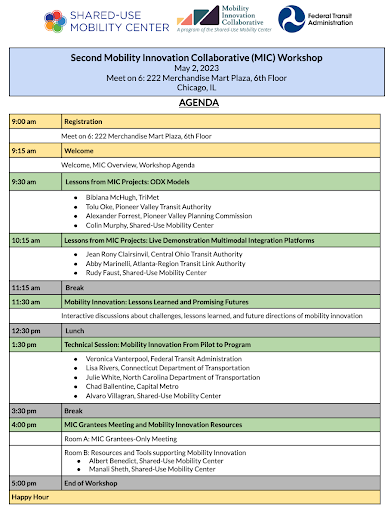
Release of a Mobility Innovation Guidebook
To open the workshop, SUMC announced the public release of the Principles to Plan, Design, & Implement Innovative Mobility Projects, a guidebook for anyone in the transportation sector interested in piloting new ideas. The guidebook is designed to support mobility innovators navigating the intricacies of planning for and demonstrating mobility projects by providing a series of nine principles agencies can consider and align with. Each principle has supporting information about strategies, case studies, resources, and questions to prompt team discussions about nine principles supporting mobility innovation. Each principle is accompanied by strategies, case studies, resources, and questions that prompt team discussion, catapult action, and help practitioners bring these principles to life.
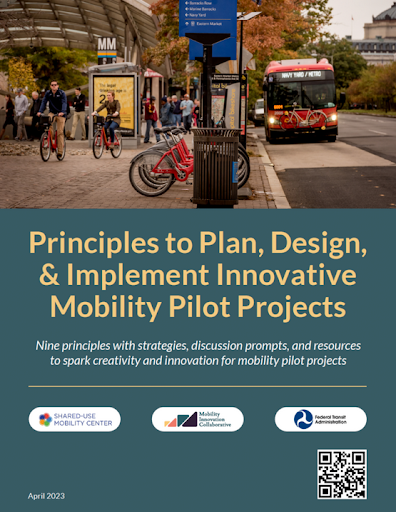
SUMC produced this guidebook with support from the FTA; input from mobility innovators from the public, private, and nonprofit sectors via surveys, workshops, and interviews; and through SUMC’s applied research, including resources from SUMC’s technical assistance work, outstanding initiatives from public and private projects, as well as from other FTA-sponsored technical assistance centers.
Mobility Innovation: From Pilot to Programs
This technical session featured a conversation with leaders from Federal, State, and local transit agencies on the evolution of mobility innovation, from pilot projects to programs. The panel of speakers included: Veronica Vanterpool (FTA), Lisa Rivers (CTDOT), Julie White (NCDOT), and Chad Ballentine (Capital Metro). The session was moderated by Alvaro Villagran (SUMC).
Federal Transit Administration’s Deputy Administrator Veronica Vanterpool began the session by highlighting how over the past 59 years, the federal government has invested in “efforts to experiment, to try new things, and to then make that new thing part and parcel of what transit agencies do as the key to transformative innovation,” emphasizing that innovative initiatives had also resulted in FTA’s own transformation.
FTA’s investments in mobility innovation pilots through various FTA research efforts have also validated new tools, technologies, service models, and systems that enable “…a well functioning mobility ecosystem that provides useful alternatives serves ecology, allowing more people to choose to travel in ways that are sustainable, for the planet, their communities, and their families.”
Vanterpool closed her opening remarks with a call to keep working on initiatives that leverage public and private assets and technologies to improve personal mobility, enhance the rider experience, and expand public transit equity and accessibility.
Bringing the perspective of innovative State Departments of Transportation, Lisa Rivers, Public Transit Administrator for the Office of Transit and Ridesharing at the Connecticut Department of Transportation (CTDOT), spoke on innovative projects happening in her state, including CTDOT’s automated bus pilot through the FTA’s Integrated Mobility Innovation (IMI) grant, CTDOT’s initiative to provide resources to Connecticut communities looking on starting microtransit pilots, and CTNext, a statewide incubator to encourage innovation and entrepreneurship.
Adding another state Department of Transportation perspective, Julie White, Deputy Secretary for Multimodal Transportation with the North Carolina Department of Transportation, discussed North Carolina’s efforts to understand emerging innovative trends and implement them in the second most rural state in the nation. These efforts include developing an autonomous shuttle project and using a RAISE grant to build a mobility hub along a rail corridor.
Finally, Chad Ballentine, Vice President of Demand Response & Innovative Mobility at Capital Metro in Austin, Texas, gave a local perspective on how to create space for innovation within a transit authority. He presented examples of innovative mobility projects Capital Metro has been developing, including Pickup, a localized on-demand transit option, and incorporating MetroBike bikeshare into the agency’s suite of mobility services.
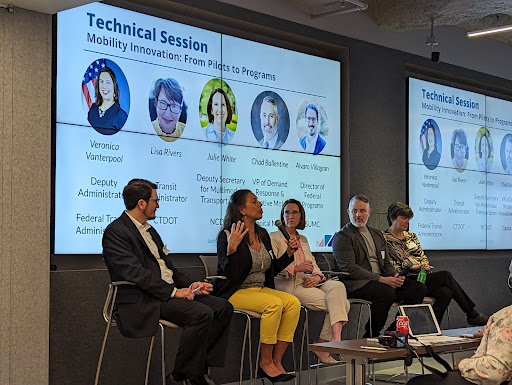
Key Takeaways
Investments in innovative projects are changing the mobility landscape. Veronica Vanterpool mentioned that the role of the FTA as a grant maker supporting mobility innovation is to invest in transit and communities, not to tell local communities, transit agencies, and technology partners how to do it. Julie White shared how when covid first happened, NCDOT jumped into getting transit to provide access to vaccines, and two weeks later they created statewide initiatives to think about the transit system differently. Lisa Rivers described CTDOT challenges in transitioning to clean fuels transit fleets and the funding and research needs associated with that systemwide transformation. Chad Ballentine shared the story of how Capital Metro and its leaders navigated a cultural change to be able to try new products and new ideas that made the agency think more holistically about people’s transportation journeys.
Rural communities across America are adopting new mobility technologies. Operators and users are overcoming previous skepticism and technology providers are refining their products to better serve the needs of rural communities. However, there is still a need for more training to help providers and users understand and use the technologies and devices that support new mobility options. Political support from local elected officials, reliable funding sources, as well as technical assistance from national and state organizations, are key to help rural communities adopt new mobility technologies.
Equity is a pillar of mobility innovation. Vanterpool emphasized the Biden-Harris Administration’s commitment to address equity in transportation through executive orders, large initiatives such as Justice40, and through grant requirements for projects receiving FTA funding. Capital Metro established equity as a key consideration to evaluate the service zones where to operate its PickUp microtransit service. Equity-related considerations represent one third of the indicators the agency uses on an annual basis to assess the need and performance of the microtransit service areas. Some state DOTs are leading the way in engaging communities beyond their large metropolitan areas to develop tools and projects to promote mobility services for all. For example, NCDOT created the Equity & Transportation Disadvantage Screening Tool to help inform decisions aimed at improving disadvantaged communities’ transportation access and mobility.
Interagency collaboration is more and more relevant to develop mobility projects, leverage funding opportunities, and address community mobility needs. While working in silos at the Federal, State, and local levels remains a barrier to develop and implement innovative projects, a growing number of initiatives and conversations promoting interagency collaboration are unlocking potential benefits. For example, at the Federal level, USDOT created the interagency NETT Council to coordinate the response of the Department of Transportation to nontraditional and emerging transportation technology projects. At the State level, both NCDOT and CTDOT presented examples where stakeholders of traditional rail and bus projects engaged with nontraditional agencies and technology partners to think creatively about addressing first-last mile issues through the collaborative mobility hub approach. Capital Metro’s formal interagency collaboration with Austin’s Department of Transportation was the key to expand the agency’s mobility services to include bike share.
Procurement process remains an issue for agencies and mobility innovators. Procurement processes remain hard to navigate and can sometimes become a barrier to develop a project, especially when procurement rules don’t provide flexibility to address the needs of new mobility projects (e.g. Buy America), or when the timelines to respond to funding opportunities are too short to put together a strong team and proposal.
Mobility innovators can take advantage of the information and resources available to fund and develop mobility innovative projects. Federal agencies such as the FTA create webinars on every Notice of Funding Opportunity (NOFO) that comes out for that specific NOFO, offer technical assistance in those webinars, and partner with organizations to provide additional technical support. More broadly, the USDOT has created the DOT Navigator as a go-to resource to support grant applications and identify technical assistance resources. Additionally, the cyclical nature of some discretionary grants allow local communities and mobility innovators to start working on their project development ahead of the time of a NOFO, providing time to understand the priorities of each funding opportunity. NCDOT’s Julie White remarked that “applying for a billion dollars takes the same amount of effort to apply for a million dollar application” and that the secret sauce to a successful application is to use the language in the NOFO in your grant application, “thinking strategically about how you reflect the administration’s goals.”
Presentations:
- Federal Transit Administration
- Connecticut Department of Transportation
- North Carolina Department of Transportation
- Capital Metro
MIC Projects developing Origin-Destination-Transfer Models
The first session of the workshop launched with Bibiana McHugh (TriMet) and Alex Forrest (Pioneer Valley Planning Commission) discussing origin-destination-transfer (ODX) models, which will allow their agencies to better estimate and analyze the full extent of how riders use of their system, from boarding to transfers to disembarking, and gain insights into ways the systems can more efficiently serve their riders. Both projects were funded by the FTA innovation grants (IMI and AIM) and were part of the MIC’s Novel Data Sources peer-to-peer workgroup. The session was moderated by Colin Murphy (SUMC).
Bibiana McHugh, Manager of Mobility & Location-Based Services at TriMet, provided an overview of TriMet’s Smart Mobility Platform, which combines a number of data sources in a validated ODX model to provide the agency data it can use for fine-grained segment level transportation analysis and planning. For instance, using the model’s outputs, TriMet found that most trips to the Columbia Industrial Corridor originated from a neighborhood without a direct transit connection. As a result, TriMet connected two transit lines to provide a more seamless travel experience between those two areas. The platform was built on open architecture, providing flexibility in adding or changing components in the future as needs evolve. The entire project is also being released under an open-source model, meaning anybody can see and use the underlying code in their own projects.
The Pioneer Valley Planning Commission (PVPC) partnered with the Pioneer Valley Transportation Authority (PVTA) and the University of Massachusetts Networks for Accessibility, Resilience and Sustainability (NARS) Lab to develop their ODX model. The project intends to address gaps in the agency’s existing data in examining travel patterns in central Massachusetts, particularly examining multi-leg trips with a goal of determining transfer hubs to make trips easier and more convenient for riders. Find a description of the project here.
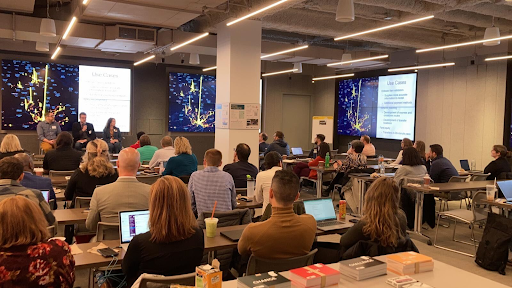
Key Takeaways
Compared to older methods, ODX Models offer transit practitioners a more accurate way to estimate travel behavior and make subsequent service changes, while preserving the privacy of individual users. With access to this data, planners can better understand current travel patterns as well as assess the impact of possible service changes before they go into effect.
Mobile ticketing and fare payment data increase the capabilities of ODX Models, and are core to validating their predictive value. Traditionally, transportation planners have relied on onboard surveys, boarding data, and automatic passenger counters (APCs) to make educated guesses at how riders were moving within and across their route networks. However, travel survey distribution can be tedious and expensive, and boarding data and APCs alone can’t account for trips that may involve transfers. Mobile apps and mobile ticket validators not only enhance fare payment, they improve data collection and can show linked trips, providing data on usage patterns that directly informs the ODX models.
When dealing with origin and destination data, agencies need to have a plan for data privacy and offer data transparency. The flipside of the fine-grained data provided by mobile fare apps is a greater threat to rider privacy if this data is not handled carefully. As more agencies use fare data to gain insights into travel patterns and improve service planning and delivery, agencies must have secure data management processes and offer transparency around what data is collected, how it’s anonymized, who can see it, and what it is used for. At TriMet, anyone using trip-specific data must sign a confidentiality agreement. Additionally, device or app identification numbers are changed monthly to protect travelers’ privacy over time. TriMet’s careful approach to handling user data (informed in part by local laws around privacy and openness of public data) resulted in a longer development process, but one that provides strong safeguards on individuals’ privacy.
Presentations:
Live Demonstration of Multimodal Integration Platforms
The day’s second session featured a walkthrough of two MIC projects that successfully pushed forward the integration of real-time technologies. Abby Marinelli of the Atlanta-Region Transit Link Authority presented ATL RIDES, a multi-modal trip planning application developed in partnership with IBI Group. JR Clairsinvil of Central Ohio Transportation Authority (COTA) presented COTA’s traffic and transit management platform, which integrates the agency’s computer-aided dispatch and planning operations with real-time traffic information and emergency services. COTA’s platform was developed in partnership with Rekor. The session was moderated by Rudy Faust, Program Manager at the Shared-Use Mobility Center.
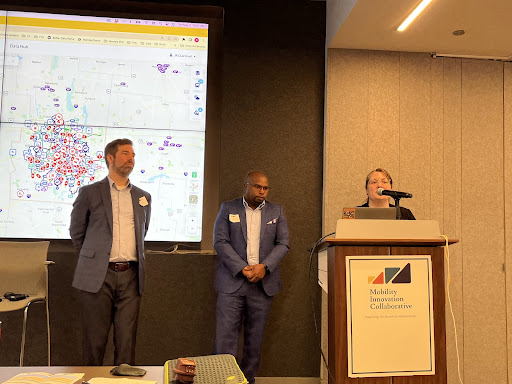
Marinelli walked the crowd through the ATL RIDES application, showing the added value it brings to riders in the region. While Google developed the General Transit Feed Specification (GTFS), users of GTFS for transit trip planning are seeing static schedules with limited functionality. Thanks to extensive backend work funded by GDOT and the IMI grant, ATL Rides now employs a GTFS-Real Time feed that represents the actual location of the transit vehicles on the road. In addition to real-time arrival and departure information and automatic fare calculation, the service includes information on wheelchair-accessible vehicles, sidewalk network condition, walking distances, and walking speeds.
The region includes agencies ranging from MARTA in Atlanta to exurban/rural operators. ATL assisted operations that might not have the capacity to help with cleaning data and other tasks necessary to implement the service. For example, sometimes multiple agencies shared a stop, but the same stop might have different names through shorthand (e.g. MLK Drive, Dr. Martin Luther King, King Dr, etc.). Marinelli showed how the data was cleaned and a broad range of services and modes could be incorporated. Future plans include fare payment capability and geographic expansion. Users who are interested in trying the Beta Test may navigate to www.atlrides.com in a browser and request access to the ATL RIDES app
JR Clairsinvil discussed COTA’s project which unifies multiple streams of traffic and transit management data onto a cloud-based platform. The project aims to improve public safety, regional collaboration, and traveler experience by unifying multiple traffic management data streams, enabling greater visibility of potential delays among disparate transit services. Like the Atlanta region, COTA’s service area includes Columbus, Ohio, a larger metropolitan hub, as well as more than ten neighboring counties. The centralized computer-aided dispatch technology gives agencies access to real-time weather and road conditions. The visual dashboard lets operators see the real-time location of demand response, on-demand, and fixed-route buses. The dashboard also displays locations of traffic incidents and will generate views from the closest camera on that route. Using this information, agencies can dynamically adjust or reroute service. The traffic management center also uses this dashboard as a tool to change signaling. Through this platform, all participating agencies see real-time transit and traffic management information, which is a significant step towards eliminating the silos between them. Information about planned closures, scheduled special events, and anticipated congestion and crashes from an artificial intelligence tool also allow agencies to anticipate possible service disruptions.
Key Takeaways
Multimodal Integration Platforms prompt transportation coordination among varying jurisdictions and counties which improves overall rider experience. Agencies working in separate jurisdictions now have access to real-time data that may impact service delivery. For instance, by making data from transportation agencies and public safety departments available on a single platform, transit agencies are able to analyze incident information and dynamically reroute their services to maintain or improve service delivery.
However, both projects face a range of capacities between the jurisdictions. These capacities are seen both in staffing and technology. Both COTA and ATL centralize the core operations as the “owners” of the program. This enables them to then share dashboards or similarly user-friendly interfaces to the participating agencies and jurisdictions. While it required extra work at the outset, and indeed throughout the pilot for ATL to reconcile the agencies’ transit feeds—the move towards data standardization means that both projects are already in the process of expanding beyond their immediate regions to allow for a seamless backend between agencies and jurisdictions.
Presentations:
Interactive Activity
Before lunch, attendees gathered for a workshop activity entitled Mobility Innovation: Lessons Learned and Promising Futures, which prompted interaction and discussion around the insights attendees gained from working on innovative mobility initiatives. Four colored postcards displaying prompts related to wish, learn, change, and challenge facilitated the activity. Attendees were broken up into partners and small groups to discuss challenges they faced pursuing mobility innovation, insights gained while working on mobility initiatives, desired resources to have while taking on mobility initiatives, and how their perspectives on mobility innovation have changed through experience.
Challenge
The Challenge group discussed the difficulties regarding data access and the limitations of working with new and emerging technologies. With many agencies pursuing projects that require new technologies on the user side, driver side, and back end, deciding what technology partnerships to engage in holds much weight. Working with private software or mobility vendors creates an environment where agencies must rely on their partners to provide up-to-standard services. Sometimes, initially promised services turn out differently than expected, particularly when accessing necessary data sets. The group noted that the rapid pace at which technology moves creates an environment where technology companies’ acquisition or turnover is not uncommon. If an agency is in contract with one company, but it is acquired, communication channels change, and project timelines lengthen. On a separate note, agencies with limited organizational capacity may struggle with implementing new technologies due to the costs associated with training staff and users.
Learn
The Learn group discussed the importance of establishing proper communication channels with partners and end-users when undertaking mobility projects . Human decision making can be complex, therefore understanding end-users’ pain points and using this knowledge when framing project goals and engaging relevant stakeholders will help build overall support. The group discussed how they iterate and test design ideas and the biggest barriers they face to iterating and being creative.
Change
The Change group discussed how to build stakeholder support of innovative mobility projects and maintain that support throughout the entire process. The group noted the challenges of being able to describe what is really needed for these projects in a way that can build agency-wide support. The group also discussed what it would take to give procurement processes more flexibility to better accommodate innovative projects. As one member noted: “procurement is rigid; innovation is not”.
Wish
The Wish group discussed the desire to have funding resources that support ongoing operations, not just infrastructure or pilot projects. Many agencies struggle to sustain projects long term due to the incessant need to find reliable funding sources in an environment where funding is already slim. The group also noted the want to have better access to travel data. Most travel data is associated with work trips but in order to measure accessibility, agencies need to go past collecting typical ridership numbers.
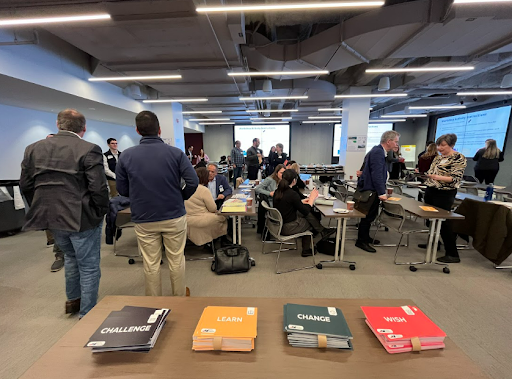
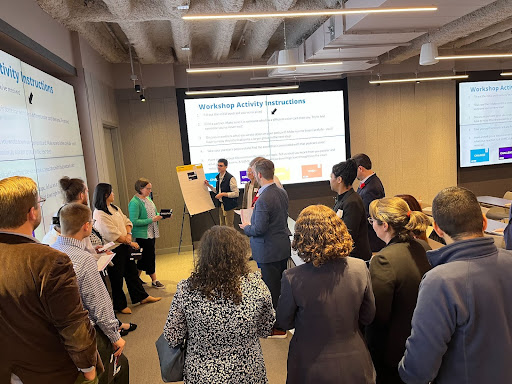
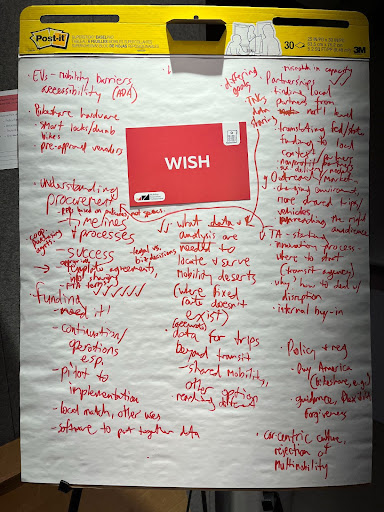
Knowledge Sharing
The final public session of the Second MIC Workshop allowed attendees to learn about recent tools and resources produced by the MIC team, including the Shared Mobility Benefits Calculator, Universal Mobility Learning Module, Mobility Interoperability Logic Model, and the Principles to Plan, Design, & Implement Innovative Mobility Projects guidebook. After a short presentation on the tools, attendees separated into breakout groups where they could review each in more detail, ask questions, and share their thoughts.
Hani Shamat and Manali Sheth (SUMC) led the breakout group on the Principles to Plan, Design, & Implement Innovative Mobility Projects. The group was intrigued by the guidebook, and had questions on how the Principles were developed, why they were organized as they were, and which parts seemed particularly relevant or useful. We received comments on how we imagine this product might scale and if cyber security could be more of a focus.
In a separate breakout session led by Nate Seeskin (SUMC), participants previewed and discussed the The Path to Mobility Interoperability. Developed through a Specs to Standards working group, this tool has a logic model that outlines what steps are necessary when implementing mobility interoperability solutions, like data specifications or mobility-as-a-service (MaaS). The logic model offers five steps toward exploring and achieving mobility data interoperability: set goals, identify needs, fill gaps, implement data standards and elements, and continue management and maintenance.
MIC Grantee-only Meeting
Similarly to the First MIC Workshop in 2022, the Second MIC Workshop provided a unique opportunity for many of the over forty agencies participating in the MIC program from all over the country to meet in person. The MIC grantee-only session allowed MIC grantees to “put a face to the name” after more than two years sharing their experiences and interacting virtually.
Given the fact that MIC grantees are affiliated with one of the five workgroups related to the type of projects they develop (namely: MOD, MaaS, Automation, Novel Data sources, and Payment Integration), this session allowed MIC grantees to meet and learn from peers across MIC working groups.
Last but not least, as MIC projects are concluding their period of demonstration, the MIC grantee only meeting offered a space for grantees to reflect on their experiences conducting their innovative mobility projects, and sharing feedback about lessons learned that can inform future FTA programs.
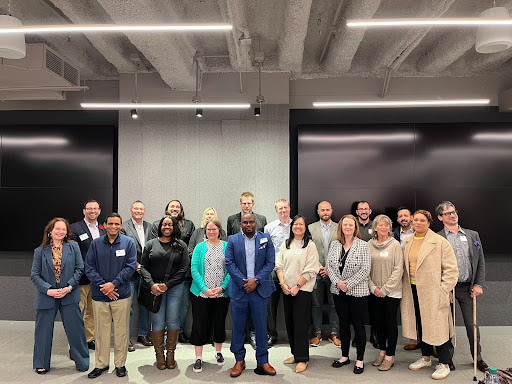
Conclusion
The MIC Workshops are a signature activity of SUMC’s technical assistance for the MIC Program. In-person workshops provide opportunities to discuss technical issues, share updates and lessons from innovative projects, have conversations with peers in an unstructured manner, and network with other mobility professionals from the public, private, and non-profit sectors.
One of the main goals of the MIC program is to foster a community for transit providers to share their knowledge and experiences in pursuing innovative transportation. Through the Second MIC Workshop, SUMC was able to convene nearly 100 transportation professionals to learn from each other and discuss their challenges, successes, wishes, and dreams for innovative mobility.